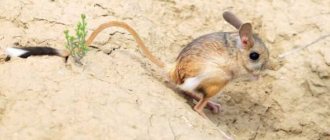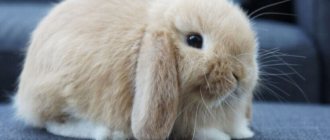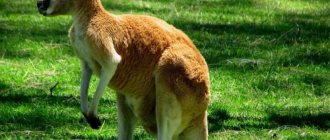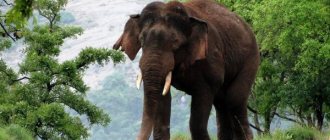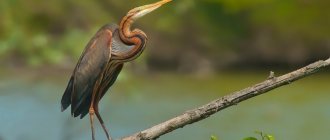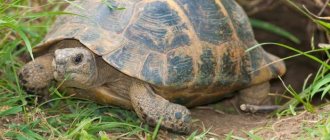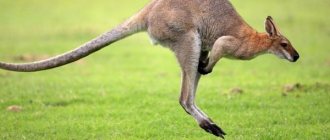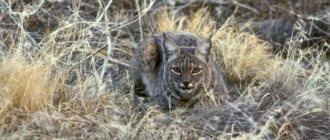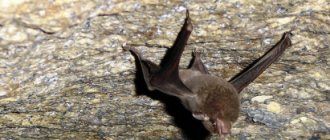Many representatives of the animal world that live on our Planet are so unique that you are simply amazed at how diverse living nature is. It is very important that people take care of these unique living beings. Jerboas are just such unique animals that appeared on Earth about 30 million years ago, while the ancestors of modern jerboas settled in Asia about 8 million years ago. After this, jerboas appeared in vast areas, including the northern regions of Africa, as well as Europe. Unfortunately, European jerboas have become extinct.
Description of the rodent
— Advertising —
The body length of jerboas varies from 4 to 25 cm. Weight is 200-300 g. The tail is usually longer than the body, 7-30 cm, with a flattened black and white tassel at the tip, which plays the role of a rudder during running and also serves as a visual aid. danger signal.
The body of the jerboa is short and short with long strong hind legs, which can be 4 times longer than the front ones. During slow movement, jerboas occasionally move on four legs, but in most cases they use only their hind legs. The length of the jump in some species reaches 3 m. The head is large, the muzzle is blunt. The ears are long, rounded, covered with sparse hairs. The eyes are large and the whiskers are long. The neck is very short.
The fur of jerboas is thick and soft. The upperparts are plain, brownish or ocher-sandy. The belly and paws are light.
Feeding ration
Not everyone knows what such an exotic animal as the jerboa eats. Meanwhile, its menu is quite varied. The optimal diet for restless animals would be a properly selected combination of plant products and meat.
Jerboas eat a variety of foods, but most of it should be grain mixtures based on wheat, oats, millet, and barley. Sometimes you can add sunflower or pumpkin seeds to the animals' diet.
Your pet will eat properly if its menu includes:
- Vegetable or fruit ingredients. Apples, cabbage, beets, and carrots are suitable.
- Protein products. Jerboas love mealworms, crickets, and grasshoppers. Sometimes your baby can be given pieces of boiled meat (chopped), a little low-fat cottage cheese, or a boiled egg. Food must be fresh.
Domestic jerboas should not add spices, seafood, or salt to their food. Sweet treats for animals are also prohibited.
What does it eat?
— Advertising —
Jerboas feed mainly on seeds and underground parts of plants, which they can dig up. Their diet also includes animal food, such as small insects and larvae. Jerboas do not drink water, but are content with what is contained in their food.
The feeding route of the jerboa is very long. For example, the comb-toed jerboa is capable of covering 7-11 km per night. An adult jerboa eats about 60 g of food per day.
Similarity to a gourmet rat
A typical jerboa bears a striking resemblance to the funny animated character Ratatouille. He is just as fast, smart and spontaneous. Watching the life of this rodent is no less interesting than watching a fascinating cartoon by Brad Bird.
By the way, we strongly recommend that everyone watch “Ratatouille” in the original. The film is full of kindness, subtle humor and culinary delights. Gourmets will be delighted!
Where does it live?
Jerboas live in temperate and tropical climates in northern Africa, southern Eastern Europe, Asia Minor, Western and Central Asia, Kazakhstan, the extreme south of Siberia up to northeast China and Mongolia. Among the landscapes, jerboas prefer sandy, clayey and gravelly semi-deserts and deserts; only certain species live in the steppe and forest-steppe zones, or in the mountains at an altitude of up to 2 km above sea level.
Life at home
Jerboas can adapt to life in captivity. Only the enclosure for keeping them must be large enough, made of metal mesh. This is if a ground hare is kept at home. The length of the cage should be up to two meters wide and one meter long. The height should also be up to 1 meter, since the animal loves to jump. At the bottom of the enclosure where the jerboa lives, you need to put dried turf in which it will dig holes. The roots found in the turf and grass will be used to make a nest. Sheep or camel wool won't hurt. The jerboa will place it in the nest.
For a medium-sized animal, it is enough to buy a large aquarium, in which turf is also placed, and for the inhabitants of sandy deserts, you need to pour sand, they love to swim in it. For dwarf animals, you can also create a habitat where the jerboa will also build a house for itself. You need turf with fine gravel and sand.
Kinds
Five-toed pygmy jerboa (Cardiocranius paradoxus)
Body length is from 5.5 to 7 cm, tail is about 9 cm long. Weight is from 9 to 18 g. The body is spherical. The head is large, on a short neck. The muzzle is elongated and pointed. The ears are small and tube-like. The fur is thick. The top of the head, back and thighs are grayish-brown or clay-gray in color with pronounced longitudinal dark streakiness. The belly, lips, neck, chest and paws are white on the inside. At the border of the back and belly there is a narrow ocher stripe. There are white or light gray spots behind the ears. The tail is grayish-brown above, light gray below.
The species is distributed in gravelly deserts and semi-deserts in the north of Central Asia and Eastern Kazakhstan.
Fat-tailed jerboa (Salpingotus crassicauda)
Body length is about 5 cm, tail up to 10 cm long. Body weight reaches 9 g. The top of the head and back are buffy-gray with dark streaking. The rings around the nose, lips, neck, chest, tummy and paws are white. White rings are visible around the ears and eyes. The tail is white below, grayish-buffy above with a light gray tassel, which in males is 2 times larger than in females.
It is found in sandy deserts and semi-deserts in northern Central Asia and eastern Kazakhstan.
Heptner's jerboa (Salpingotus heptneri)
It is about 5 cm long, the tail length is up to 10 cm. The average weight is about 9 g. The color resembles a pale jerboa, the top of the head and back are covered with gray fur, the tail is densely pubescent with a black tassel.
The species is endemic to deserts in the south-east of the Aral Sea region.
Pallid jerboa (Salpingotus pallidus)
Reaches 5.5 cm in length, with a tail length of about 10 cm. Body weight is about 10 g. The body is short, spherical. The head is big. The muzzle is elongated. The eyes are big. The tail is thickened and decorated with a tassel. The back and top of the head are yellowish-gray with dark longitudinal streaking. The ring around the nose, lips, neck, chest, tummy, paws are pure white. The tail is light with a dark tassel.
Endemic to Kazakhstan, where it lives in sandy deserts.
Balochistan jerboa (Salpingotulus michaelis)
The body length does not exceed 3.6 cm, the tail is up to 7 cm long.
Distributed in Pakistan, Afghanistan, at altitudes of 1000-1600 m above sea level.
Hairy jerboa or arrow jerboa (Dipus sagitta)
The body is short with a long tail. The fur is thick and soft. Colored from pale sandy yellow to dark grayish-brown with pronounced dark streakiness. The sides of the body and cheeks are light. The inside of the lips, throat, breast, belly and paws is pure white. The tail is light with a long, black and white tassel.
The habitat of the species includes sandy deserts and semi-deserts in the southeast of Russia, Kazakhstan, Middle and Central Asia, Altai Territory, Iran.
Turkmen jerboa (Jaculus turcmenicus)
Body length 12-14 cm. Ears are large. The back is pale, grayish-sandy in color. The belly is white. The tassel on the tail is pure white.
A rare species that is common in the west of Turkmenistan and in the north-west of the Kyzylkum desert.
Dzungarian emur (Stylodipus sungorus)
Outwardly, it resembles an ordinary eurasian. Lives in deserts and semi-deserts of southwestern Mongolia and China.
Common murmur (Stylodipus telum)
Body length 9-12 cm. The head is rounded, the muzzle is shortened, the ears are small. The tassel on the tail is dark. The back is brownish-gray to ocher-brownish in color, the belly is white.
Found in China, Kazakhstan, Turkmenistan, Ukraine, Uzbekistan, Russia.
Long-eared jerboa (Euchoreutes naso)
It differs from other species by its exceptionally large ears. Lives in the deserts of Mongolia and China. The species has been assigned the status of “endangered” and is also included in the Red List of the World Conservation Union (IUCN).
Lesser jerboa (Allactaga elater)
Body length from 5 to 15 cm, tail length from 7 to 25 cm, body weight 44-73 g. The tail is long, the eyes are large. The back is dark-gray. The sides are light. The neck, chest, and belly are snow-white.
Lives in Afghanistan, Armenia, Azerbaijan, China, Georgia, Iran, Kazakhstan, Kyrgyzstan, Mongolia, Pakistan, Russia, Tajikistan, Turkey, Turkmenistan, Uzbekistan, in desert and semi-desert regions.
Greater jerboa or ground hare (Allactaga major)
Body length is from 18.7 to 26 cm, tail length is from 25 to 30.5 cm. Weight reaches 300 g. The head is rounded with a pronounced neck. The muzzle is elongated and wide. The ears are short. The back is brownish-ochre or brownish-gray to pale sandy in color. Cheeks are light. The throat, chest, belly and paws are white inside. The outside of the paws are rusty yellow. The tassel on the tail is black and white.
The species is found from forest-steppe to semi-deserts and deserts of Eastern Europe, Kazakhstan and the south of Western Siberia.
Fat-tailed jerboa (Pygeretmus platyurus)
Body length is from 8 to 10 cm. Tail length is about 90% of body length. Weight ranges from 25 to 55 g. The head is small, the muzzle is short. The eyes are large and black. The tail is thick, light with a dark tassel. The fur is thin, thick, the top of the head and feet are dark. The lips and cheeks are dirty gray, the throat and belly are yellow-gray, sometimes with white spots.
The species is distributed in Kazakhstan and northwestern Turkmenistan.
Tarbaganchik (Pygeretmus pumilio)
Body length is from 9 to 12 cm. The head is wide, the ears are small. The back is brown, the belly and paws are white.
The species lives in the Don Region, in the north of the Caspian Sea, in the Lower and Middle Volga region, Central Asia, China, Mongolia, and Iran.
Zhitkov's jerboa (Pygeretmus zhitkovi/shitkovi)
Body length is about 10 cm, tail length is 9-14 cm. Weight is about 60 g. The head is large with a pronounced neck. The ears are long. The back and head are light with dark streaking. The lips and throat are white. The sides are light, the breast and belly are light buffy. The tail is thick with a lush brownish-black tassel.
Endemic to southeast Kazakhstan, vulnerable species.
Comb-toed jerboa (Paradipus ctenodactylus)
The body length is about 15 cm, the tail reaches 20 cm in length. Weight is about 150 g. The body is short. The head is big. The muzzle is elongated. The tail is not thickened, yellowish with a gray tassel. The fur is thick and soft. The head and back, and paws on the outside are sandy-yellow in color, with dark streakiness. The sides are lighter than the back. The rings around the nose and eyes, lips, neck, chest, belly, and paws are pure white on the inside. A large buffy spot is noticeable on the throat.
Lives in the sandy deserts of Central Asia and Northern Iran.
Purchase rules
Buying a pet jerboa is an easy task, but you need to understand that even such an unpretentious animal must be chosen correctly. There are a lot of advertisements on the Internet for the sale of these animals, but most zoologists and rodent lovers do not recommend buying an animal from someone else, and this is not without reason.
The fact is that these mammals reproduce in artificial conditions quite difficult. Only serious private nurseries or zoos can breed healthy offspring. When rodents breed at home, the offspring come out weak, without immunity to many diseases. Such an animal can be sick with anything. It is also worth noting that offspring born in the makeshift conditions of an apartment can be completely wild and experience hostility towards humans.
The guinea pig is one of the most popular, beloved and safest pet rodents, which is very important if there are children in the house.
But even in the pet store you should keep your eyes open. Often sellers do not have time to observe the animals, and sick animals may be located next to healthy ones. The jerboa should be mobile and active, the fur should be clean and smooth, without lumps, and the eyes should be shiny. All this, as well as a good appetite, indicate the excellent health of the future pet.
You can often observe swelling of the lower legs of store-bought jerboas. This pathology is not a complex disease; it occurs due to the cramped living environment. When moved to a large cage, the disease goes away on its own, so there is no need to be afraid of such jerboas.
Behavior
Jerboas are usually nocturnal and crepuscular animals; during the day they remain in burrows. But, for example, daytime jerboas are also found on the territory of Kazakhstan.
Jerboa burrows are divided into 4 types. Rescue holes are simple passages 10-20 cm deep. Temporary daytime holes are from 20 to 50 cm in length, the entrance is closed with a plug of earth or sand, which keeps cool and moist inside. The permanent burrows are complex, containing a main inclined tunnel and several blind backup tunnels. If they start digging up a jerboa’s hole, it breaks one of the emergency passages and runs away. In the depths of the main tunnel there is a round-shaped living chamber, lined with chopped grass. The last type of burrows - wintering ones - are dug at a depth of 1.5-2.5 m, and consist of underground storerooms and a wintering chamber.
During the winter, many species of jerboas hibernate, just like dormouse.
Natural enemies
It is difficult to describe all the enemies of jerboas, since they are hunted by all predatory species. Small rodents are attacked by predatory animals, birds and reptiles. They are happily eaten by foxes, dogs, and representatives of the cat family.
Human activity also has a detrimental effect on small animals. Despite the fact that no one hunts most species of jerboas, rodents die during cultivation of fields, burning of bushes, construction of cities, dams, roads and other economic activities.
To some extent, fires and floods can be considered natural enemies. No matter how fast the jerboa is, it cannot escape from a steppe fire or escape from a stream of water. During floods and heavy rainfalls, many rodents become trapped in “houses” and die.
Reproduction
Reproduction in jerboas occurs 1-2 times a year, and begins after hibernation.
Pregnant females appear from March to July. Pregnancy lasts 25 days. One litter contains from 1 to 8 (often 4-6) babies. For births in a burrow, a special brood burrow is allocated. The cubs are born blind and naked; in appearance they look like baby rats. Feeding lasts 1.5-2 months.
When they first emerge from the burrow, the cubs look almost like adults. At first they stay close to their mother, following her and using her burrow. Having reached a body weight of 200-220 g, young jerboas begin an independent life.
The lifespan of jerboas in nature is up to 3 years.
A nimble and timid nocturnal inhabitant of deserts
This chapter will tell you about the life of jerboas in the wild. These amazing rodents lead a certain way of life, let’s look at its features:
- Separateness. Jerboas walk on their own, and come together only to reproduce.
- They are awake at night and rest in their burrows during the day.
- They don't like to take risks. The small and nimble animal will never get out of its home unless necessary, because it knows how dangerous and cruel the animal world is.
- They are excellent diggers. This skill is necessary for building underground dwellings. Very often, a rodent encounters compressed soil that cannot be raked with its front paws. In this case, sharp front fangs are used. In this example, you can again see how harmonious and correct Mother Nature is.
Interesting facts about the jerboa
- Jerboas have a positive effect on the soil in which they live and serve as food for desert predators. But they also cause damage because they damage plants that strengthen sands, feed on cultivated plants, and transmit a number of diseases, including plague.
- Scientists have determined that close family ties between young jerboas last only up to 3 months; later they begin to show aggression towards each other, which accelerates their settlement.
- The Balochistan jerboa is recognized by the Guinness Book of Records as one of the smallest rodents in the world after the northern dwarf hamster.
Red Book
Where jerboas live in Russia, and this is the Voronezh region, Usmansky Bor and Bogucharsky district, certain species of them are listed in the Red Book. The limiting factor was the reduction of habitat areas due to changes in the regime of agricultural use of territories. It was also influenced by weak population replenishment and slow development of young individuals to sexual maturity.
There are populations of the large jerboa in Russia in the European part, and these are the Moscow and Gorky regions. Their numbers increase closer to their southern habitats.
Is it possible to let her go for a walk around the apartment?
It is strictly not recommended to release jerboas from their cages. These animals are not friendly to humans; at the first opportunity, your pet will run away from you. After this, the rodent will find a quiet place and begin to create a hole. In this case, even the walls of buildings will not stop him. In one night, an average-sized animal can make a hole about 30 cm in a concrete wall, and about 50 cm in a brick wall!
